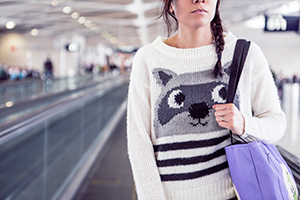 Recently a friend told me how her mother used to order one new outfit per season, complete with all accessories such as gloves, stockings and handbag, and once fabrics and styles had been carefully chosen, the outfit would be made to measure by a local seamstress and worn throughout the season. Being a bespoke and carefully considered purchase, it was far less likely you might bump into someone else wearing the same outfit, nor would it be bought in a fit of impulse only to languish, unworn, at the back of the wardrobe. But such a cottage industry production model wasn’t economically sustainable in the long-term for the growing population of fashion consumers. Fast forward to today’s efficient mass production model, with vertical disintegration and outsourcing of manufacture to unknown people in faraway factories, and we are now very much removed from the process of our clothes being made. With mass production and fast fashion, we have certainly gained a number of benefits including the democratisation of fashion, endless product variety, cost efficiencies and the ease of buying off the peg from a myriad of retail channels, but have we lost some appreciation of our clothes along the way? We buy more items but discard them more quickly than ever before – it can even be cheaper to buy a new item than it is to launder an existing one – which contributes to the environmental problems of increasing textile waste and resource depletion.
Recently a friend told me how her mother used to order one new outfit per season, complete with all accessories such as gloves, stockings and handbag, and once fabrics and styles had been carefully chosen, the outfit would be made to measure by a local seamstress and worn throughout the season. Being a bespoke and carefully considered purchase, it was far less likely you might bump into someone else wearing the same outfit, nor would it be bought in a fit of impulse only to languish, unworn, at the back of the wardrobe. But such a cottage industry production model wasn’t economically sustainable in the long-term for the growing population of fashion consumers. Fast forward to today’s efficient mass production model, with vertical disintegration and outsourcing of manufacture to unknown people in faraway factories, and we are now very much removed from the process of our clothes being made. With mass production and fast fashion, we have certainly gained a number of benefits including the democratisation of fashion, endless product variety, cost efficiencies and the ease of buying off the peg from a myriad of retail channels, but have we lost some appreciation of our clothes along the way? We buy more items but discard them more quickly than ever before – it can even be cheaper to buy a new item than it is to launder an existing one – which contributes to the environmental problems of increasing textile waste and resource depletion.
Addressing these challenges requires multi-stakeholder action plans. But as consumers, how can we reconnect with our clothes and thus limit the negative effects of our fashion consumption? Could we stop buying so much and try to buy fewer pieces that we really love to wear? Some high street retailers seem to be encouraging this, such as Jigsaw with their ‘For Life not Landfill’ modern classics campaign which creates the perfect antidote to the endless trends and throwaway fast fashion culture, and Levi’s with their Tailor Shop, for customising denim or for giving a new lease of life to a much-loved existing Levi’s product. The Fashion Revolution #whomademyclothes social media campaign also encourages us to stop, reflect and try to reconnect with the people that make our clothes.

The Life Story of your T-shirt
This blog was written as part of an online event run by The Institute for Social Marketing as part of the Festival of Social Science week (7th-14th November 2015).
Visit our event hub to learn more about how t-shirts are made, make decisions about sustainability and share the story of your own favourite t-shirt.
Rate and Review
Rate this article
Review this article
Log into OpenLearn to leave reviews and join in the conversation.
Article reviews
Best regards.
Sandra Gutiérrez
https://el-club-de-costura.blogspot.com/2018/07/produccion-masiva-y-la-consecuente.html